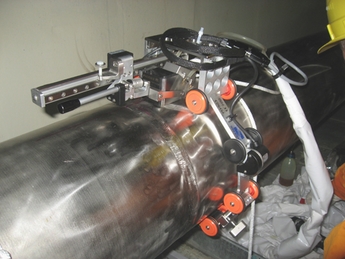A new belt scanner for the inspection of stainless steel pipe welds within nuclear reactors has been created by Phoenix Inspection Systems for the German inspection company VOGT Ultrasonics.

The manual dual-axis scanner is ideal for testing pipe-to-pipe and pipe-to-elbow welds, suitable for most phased-array inspections. Based on the popular Beltman from Phoenix’s range of inspection aids and scanners, it runs around the pipe on a roller belt, enabling complete 360° inspection.
The scanner has an axial range of 250mm and the axial position is adjustable relative to the clamping belt, allowing it to clear obstructions such as other pipe nozzles. A bridge section allows the probes to inspect in the same area as the clamping belt so the complete inspection can be achieved from one position.
As a belt, it can be used on any pipe material and is quick to mount, adjust and remove. The belt length is extendable and similarly probe wedges can be interchanged for use on different diameter pipework. It is compatible with any two-axis inspection instrument.
Neil Hankinson, project manager at Phoenix, said: “VOGT is introducing phased array techniques for pipe weld inspection and required a scanner specifically designed for this purpose. There were several welds to be inspected requiring the scanner to operate in multiple locations with a variety of physical access limitations. In some areas there was less than 100mm clearance above the welds - in others there were branch pipes close to welds, causing an obstruction.
“The new scanner offers a flexible solution which may be adapted to achieve complete scan coverage from a single clamping location. Tests have shown that the scanner provides a fast, simple and reliable inspection, and when used in conjunction with the phased array techniques has been observed to exceed the standards of previous inspections.”
Utilising the Beltman scanner, the inspection technique has subsequently been approved and certified in Germany for testing stainless steel pipes from 250-350mm in diameter with wall thicknesses from 20-30mm.




